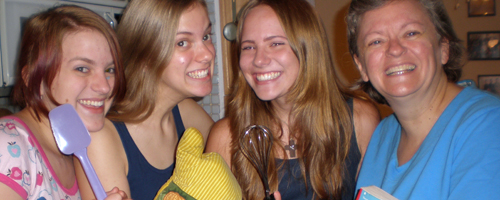“I strive to make as much as possible enjoyable and educational at the same time.”
Amy Santee
 Amy Santee (far right) used MIT course Kitchen Chemistry to teach basic chemistry concepts to her homeschooled daughters.
Amy Santee (far right) used MIT course Kitchen Chemistry to teach basic chemistry concepts to her homeschooled daughters.Kate James | MIT OpenCourseWare
Homeschooling her daughters means that Amy Santee knows how to think outside the box. She takes them on field trips to places like Gettysburg Battlefield and the Smithsonian Institution to make lessons more tangible and immediate, and finds a wide variety of outside activities for them like ballet and choir. Her freedom to step outside the classroom keeps the lessons fresh and exciting. "I realize that not all learning is fun," says Santee. "But I strive to make as much as possible enjoyable and educational at the same time."
"They don't particularly like science," says Santee. "So I wanted to find something that would be worth a high school credit of lab science that the girls might actually enjoy." A friend sent her to MIT OpenCourseWare's Highlights for High School. "Homeschoolers tend to have this unofficial emailing system. When we find something that we like or that we think would be helpful to someone else, we email each other. It's not official, just passing information among friends."
In ES.287 Kitchen Chemistry, fundamental concepts of chemistry are explored in the kitchen. Students keep detailed journals of their findings as they learn about the "blue" in blue cheese, find out why scone dough is never kneaded long, and observe what happens to sugar when it's heated with a blow torch. Santee and the girls were loathe to buy a blowtorch, and liquid nitrogen can be surprisingly hard to come by. But they improvised with another ice cream recipe and put the crème brûlée under the broiler.
"There was not much writing involved," says Santee, "so at the end of the year I had them choose any topic from the class and write a standard essay. Then they read their reports out loud at our final class where the girls served their final 'experiments' of spaghetti and meatballs, and crème brûlée. I added a little party, an essay, and a speech just to round out the class."
Santee notes that Food Network's "Good Eats" made an excellent supplement to the course, and that the text recommended for this course, On Food and Cooking, The Science and Lore of the Kitchen, was particularly good. "The information about the history of food and cooking was well placed to break up difficult chemistry explanations."
"I find that adding these little things throughout the year helps balance out the time that I spent working our way through textbooks," says Santee. "I thought that perhaps the girls would enjoy the cooking part of the class, not the science. But they did enjoy it, and now they can apply what they learned in this class to other cooking experiences."